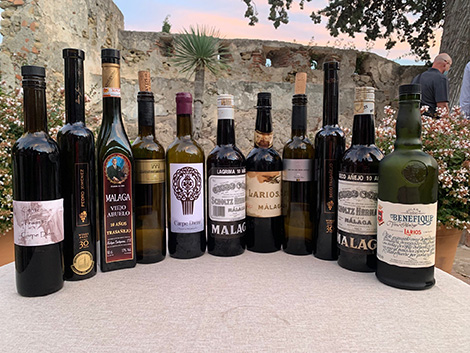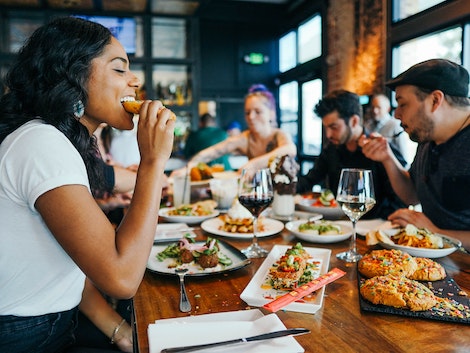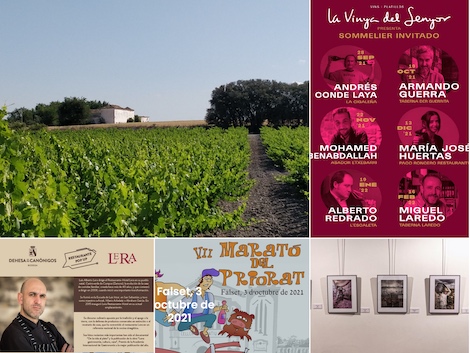A tasting of the historic and largely forgotten wines of Malaga

Despite its intricate wine styles and winemaking techniques, few areas have preserved their traditional methods and old classifications as rigorously as Málaga has. A tasting hosted by the Regulatory Board of the DO earlier this month gave us the chance to go over many of them as well as to try wines from defunct wineries.
Visiting Dimobe the following day, one of the few bodegas producing the myriad of styles described in the appellation, was a helpful follow-up. So was re-reading the comprehensive book* written in 1792 by Cecilio García de la Leña, when Málaga wines were at their peak.
The sea views from Castillo de Santa Catalina provided a timely reminder of the international scope of the city’s wines, which were successfully exported from its bustling port across Europe, including Russia, and to America once the trade with the West Indies was authorized in 1765.
Pedro Ximénez’s old reign
The wines in the 18th century were made from Pedro Ximénez grown in Montes de Málaga, the wine producing region closest to the city, thus ensuring a convenient supply for the flourishing trade in its port.
This may be the reason why most of the wines chosen by José Manuel Moreno Ferreiro, general secretary of the DOs Málaga and Sierras de Málaga, for the tasting were made from Pedro Ximénez. García de la Leña described this grape variety as "white, very sweet, with a very distinctive sugar quality, supple skin, plump, neither round nor long, very tasty [...], giving plenty of juice". Accordingly, the most appreciated wine of his time was Pero Ximen puro y legítimo (pure, genuine Pero Ximen, spelled without the "d"). Below were other wines made from varieties that were blended with Pedro Ximénez must to produce Pero Ximen mixto (García de la Leña's impassioned defence of co-fermentation is strikingly modern) or Tinto (red) by adding red grapes to add colour rather than flavour. Even Moscatel wines were made by adding crushed clusters of this variety to Pedro Ximénez musts; producing Moscatel separately was rare at that time.
Nowadays, Pedro Ximénez is grown to a very small scale in Montes de Málaga, where sadly very few vineyards remain (Victoria Ordóñez makes an excellent dry wine here called Voladeros) but it is widely planted in the Norte subarea, the natural prolongation of Montilla-Moriles vineyards into the province of Málaga. Some of Málaga’s most prized sweet wines at present come from Axarquía, a region to the east of Montes de Málaga where Moscatel, mainly destined to produce dried grapes, is the dominant variety.
Evolving styles
As Moreno Ferreiro recalled while reading some excerpts from García de la Leña's book, Málaga wines gained international renown before fortification became a widespread practice. In fact, García de la Leña's work (the book was actually written by his uncle Cristóbal Medina Conde, a priest vetoed by the ecclesiastical tribunal and by King Carlos III) was meant to defend purity against adulteration "with eau de vie and other mixtures". From 1750 onwards, alcohol was added to "flimsy and thin wines" to withstand sea voyages. The style turned out to be very much appreciated by the English. This is exactly the period when the Marquis of Pombal set the boundaries of Port vineyards and regulated its production in order to favour trade with the British.
Instead of alcohol addition, García de la Leña calls for a set of good practices ranging from optimal harvesting times in early, intermediate and late-ripening plots to as much as three different picking stages, each time sorting out bunches and removing damaged, rotten or sour berries; proper sun-drying exposure for each type of wine; co-fermentation with arrope (boiled grape must reduced by half or a third) in the right amounts and subsequent rackings and natural clarifications during the ageing process.
Many of the wine styles described in his book have survived to this day. This is the case of tierno, a wine with high sugar levels made from sun-dried grapes which in the past was used to fix “coarse, dried” wines not just locally, but also in countries like France or Germany. 21st century tierno wines follow the same process to obtain sugar levels ranging between 300 and 400 g/l, but are now fortified.
Bodega wines
Part of the enormous complexity of DO Málaga wines derives from the fact that many different elements are classified: sugar levels (dry and sweet), whether or not alcohol is added (liqueur or naturally sweet wines), ageing times (noble, añejo, trasañejo), the type of grape must (lágrima is obtained without mechanical pressure; vendimia asoleada comes from sun-dried grapes) and colour, usually to the amount of added arrope (the more, the darker).
In practice, producers use different base wines, including naturally sweet wines and liqueur wines. The latter are further divided into tiernos, dulces naturales (vin doux naturel, made from grapes which have not been sun-dried and by adding alcohol to stop fermentation) and maestros (alcohol is added at the very beginning so fermentation takes place so slowly that it doesn’t finish, resulting in a sweet wine). Other possible additions include dry wines, arrope and concentrated grape must.
The tasting featured two such wines, both of which were drawn directly from the cask. The first one is part of the blend of Málaga Virgen Abuelo 10 Años Trasañejo made by Bodegas Quitapenas. Despite its 300g of sugar, it didn’t taste too sweet and it was obvious that its edges needed to be softened. The second one was an ancient Solera known as “Napoleón’s cask”. Created by Bodegas Scholtz, it has been kept at Virgen de la Oliva cooperative in Mollina and is part of the blend of Carpe Diem, their range of old wines. This was thick and powerful, somewhat exotic on the nose and nicely textured; the fact that acidity has concentrated through the years makes it a valuable tool to build or improve blends.
The personal touch of each producer also matters. In Moclinejo, in the heart of the Axarquía region, Juan Muñoz from Dimobe told us that his father used to produce three types of wines: a vin doux naturel he referred to as “corriente” (ordinary), a more concentrated “especial”, and a dry white aged under flor (a veil of yeasts). As the latter aged, the veil of flor disappeared, similarly to a Sherry Amontillado, and was eventually released as Arcos de Moclinejo PX Trasañejo Seco. This was our first sip at the tasting.
Although trasañejo means that a wine is at least five years old, Arcos de Moclinejo is over 30 years of age. It had the sapid, distinctive salty almond aromas found in wines that at some point have been aged under flor. And this was so despite the fact that it was blended with younger, fresher wines before its release.
The Trasañejo Seco PX made by López Hermanos that we tasted next to it was very different. Made from a dry Pedro Ximénez fortified to 18% abv. and blended with a vino tierno from the same variety, it had 20 g of sugar. Its average age also exceeded 30 years. It showed more concentrated with lots of dried fruits and pistacchio notes on the finish. Founded in the late 19th century, López Hermanos is another historic bodega in Málaga.
Bottle versus cask aging
Old wines made by defunct bodegas were marked by additional bottle aging. The Málaga Seco Añejo 10 Años, made by Bodegas Scholtz Hermanos, was most probably released shortly before the mid-1990s, when the company went out of business.
The Scholtzes were one of the many German families who settled in Malaga to produce and trade in wines after the English shifted their interest to Sherry. Established by brothers Christian and Emilio Scholtz in 1807, the house pioneered large-scale winemaking. Showing less concentration, the Seco Añejo’s main feature was its silky texture and refinement resulting from its extended bottle ageing.
Larios is another pivotal family in Malaga since the end of the 19th century. Initially involved in the textile and sugar industries, the winery was founded by José Aurelio, the third Marquis of Larios, in the first third of the 20th century. The company was also behind the eponymous and popular Larios gin and the 1866 brandy, now owned by Osborne. The business was taken over by Pernod Ricard in 1974.
From Larios we tasted Benefique Vino Oloroso, a 25-year-old wine which was probably released in the 1990s. The exotic, herbal and vanilla aromas reminded me of some of the old Toro Albalá PX from Montilla-Moriles. José Manuel Moreno ventured that some tierno or concentrated must might have been blended in. The wine felt sweet yet balanced and full of energy. It was one of my favourite wines.
Moscatel Dehesa, also from Larios, was the only wine produced from this variety in the tasting, yet the grape’s distinctive character was blurred by the use of arrope. It was apparent in the dark, iodine-tinged colour, its thickness and roasted character, to the point that the time spent in bottle didn’t seem to have rounded teh wine. In a similar style, arrope also marked Scholtz’s Lágrima 10 Años but it felt more elegant, with cream caramel notes offsetting the roasted character.
It was interesting to compare these with the two sweet, over 30-year-old PX Trasañejo wines made by López Hermanos and Dimobe. Whilst López Hermanos’ Don Juan stood in line with the style of PX made in Montilla-Moriles, Dimobe’s Arcos de Moclinejo felt sweeter (creme caramel) and more alcoholic.
The 21st century
Modern consumers are not particularly fond of sweet or traditional wines, but the enthusiasm of people like Juan Muñoz, who continues to explore ancient styles at Dimobe, is remarkable. In 2016 he decided to make a wine in the 18th century style fermenting a blend of Pedro Ximénez, Moscatel and arrope to 15% abv. Since then, it has been ageing in a cask that had previously contained brandy. A tiny sample has been sent this month as a preview to the members of Contubernio, a wine club with a strong focus on Andalusian wines, but Muñoz plans to release it in 2027.
He is also trying to recover the dry wine aged under flor made by his father. Muñoz’s first blend containing 90% Moscatel and 10% Palomino has easily developed a thick layer of yeasts.
In addition, he makes pajarete, a finicky style that has to meet many different requirements. Made without arrope, the wine must be aged for at least two years, its colour ranging from golden to dark amber, and sugar content between 45 and 140 grams. Dimobe’s pajarete is six years old. Tasted directly from the cask, it showed moderate concentration and sweetness, thus approachable and balanced. With a reddish hue, the blend was made from vin doux naturel, maestros and old dry wines.
"All elements gain concentration in cask: alcohol, sweetness, acids," says Juan, who stresses that one must be vigilant so pajarete does not lose its condition during the ageing process. This year he refreshed it with La Raspa, the regional, entry-level white made by Viñedos Verticales.
Viñedos Verticales (the name refers to Axarquía’s steep slopes) is his partnership with winemaker Vicente Inat to produce modern-style, terroir-driven wines in DO Sierras de Málaga. An exception is the sweet Noctiluca, which is presented as vendimia soleada given that it is made with sun-dried grapes. Fermentation is stopped by cooling down the must resulting in a wine with low alcohol content (10.5% abv.) and around 175 g of residual sugar. The main challenge, says Juan Muñoz, is to stabilize the wine so that it does not referment.
As in García de La Leña's time, all the ingredients used in this style comes naturally from the grape. In the end, the future is not at odds with the past.
* Dissertation recommending and advocating the famous pero ximen wine from Malaga and how to make it.
** DO Málaga is the seal for traditional and historical wines, while DO Sierras de Málaga includes still wines from the various sub-areas in the province.

Amaya Cervera
A wine journalist with almost 30 years' experience, she is the founder of the award-winning Spanish Wine Lover website. In 2023, she won the National Gastronomy Award for Gastronomic Communication
Wine tastings in October 2021
NEWSLETTER
Join our community of Spanish wine lovers






